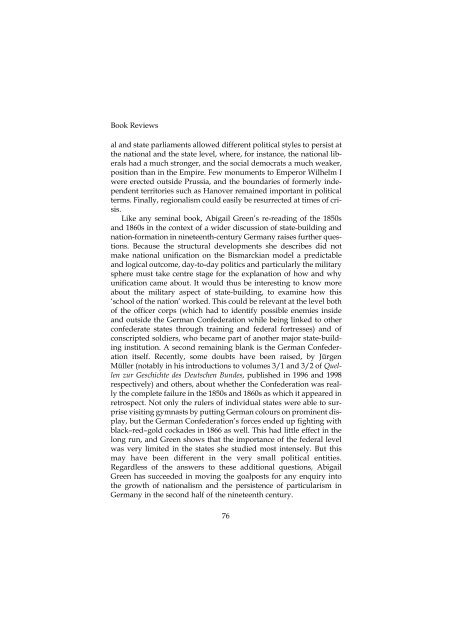Download - German Historical Institute London
Download - German Historical Institute London
Download - German Historical Institute London
Create successful ePaper yourself
Turn your PDF publications into a flip-book with our unique Google optimized e-Paper software.
Book Reviews<br />
al and state parliaments allowed different political styles to persist at<br />
the national and the state level, where, for instance, the national liberals<br />
had a much stronger, and the social democrats a much weaker,<br />
position than in the Empire. �ew monuments to Emperor Wilhelm I<br />
were erected outside Prussia, and the boundaries of formerly independent<br />
territories such as Hanover remained important in political<br />
terms. �inally, regionalism could easily be resurrected at times of crisis.<br />
Like any seminal book, Abigail Green’s re-reading of the 1850s<br />
and 1860s in the context of a wider discussion of state-building and<br />
nation-formation in nineteenth-century <strong>German</strong>y raises further questions.<br />
Because the structural developments she describes did not<br />
make national unification on the Bismarckian model a predictable<br />
and logical outcome, day-to-day politics and particularly the military<br />
sphere must take centre stage for the explanation of how and why<br />
unification came about. It would thus be interesting to know more<br />
about the military aspect of state-building, to examine how this<br />
‘school of the nation’ worked. This could be relevant at the level both<br />
of the officer corps (which had to identify possible enemies inside<br />
and outside the <strong>German</strong> Confederation while being linked to other<br />
confederate states through training and federal fortresses) and of<br />
conscripted soldiers, who became part of another major state-building<br />
institution. A second remaining blank is the <strong>German</strong> Confederation<br />
itself. Recently, some doubts have been raised, by Jürgen<br />
Müller (notably in his introductions to volumes 3/1 and 3/2 of Quellen<br />
zur Geschichte des Deutschen Bundes, published in 1996 and 1998<br />
respectively) and others, about whether the Confederation was really<br />
the complete failure in the 1850s and 1860s as which it appeared in<br />
retrospect. Not only the rulers of individual states were able to surprise<br />
visiting gymnasts by putting <strong>German</strong> colours on prominent display,<br />
but the <strong>German</strong> Confederation’s forces ended up fighting with<br />
black–red–gold cockades in 1866 as well. This had little effect in the<br />
long run, and Green shows that the importance of the federal level<br />
was very limited in the states she studied most intensely. But this<br />
may have been different in the very small political entities.<br />
Regardless of the answers to these additional questions, Abigail<br />
Green has succeeded in moving the goalposts for any enquiry into<br />
the growth of nationalism and the persistence of particularism in<br />
<strong>German</strong>y in the second half of the nineteenth century.<br />
76













